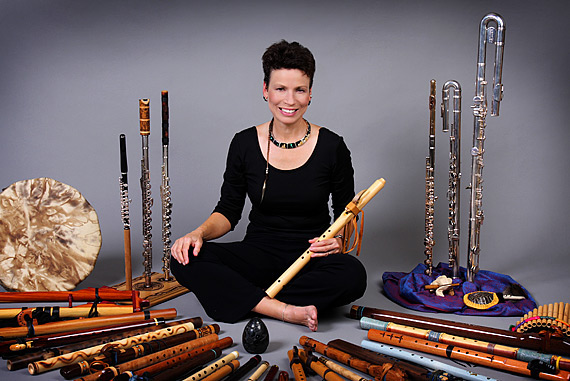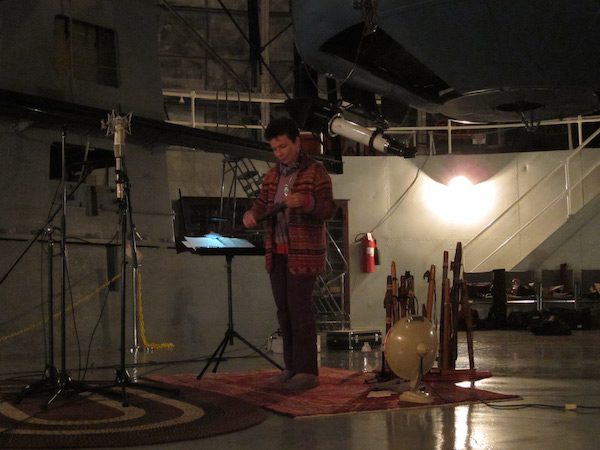- Published: Wednesday, September 09 2015 00:37
I’m honored to be the AstroArtist for the month of September, 2015. In this 4-part blog, I’ll talk a bit about my musical background, the inspiration behind the astronomy-based theme of my album Under The Stars, and the recording/mastering process. Recorded live on location November 2, 2014 in the 100-inch Hooker telescope dome at Mount Wilson Observatory (Pasadena, California), the album follows in the path of Paul Horn’s famous 1969 album Inside The Taj Mahal. In a similar fashion, I wanted to capture a completely improvised, live musical experience that was specific to the place, the time, and the amazing acoustical properties of the building itself. For this project, I decided that the musical themes for the improvisations would be based on or inspired by the night sky, in particular on the star legends of various Native North American tribes.
The album cover was shot on a separate trip a few months later, in January 2015. We decided to use the 60-inch dome for the photo, because it is smaller and made the flute-player (me) appear larger and more recognizable. Jaspar Johal - a long-time friend, commercial fashion photographer and astronomy aficionado, shot the amazing time-lapse scene with a fish-eye lens. Timing the shoot to happen just after twilight, we were able to capture Orion (and the Pleiades) in the observatory dome opening.

A classically trained flutist, I was always interested in flutes from other cultures, and over the years had collected an assortment of bamboo, wood and ceramic flutes from around the world. When I saw my first Native American flute in a gift shop in Boulder Colorado, back in the early 90’s, I didn’t even know what it was – but I picked it up, played a few notes on it and was immediately hooked. My husband Nik & I were on a camping trip at the time, and I would sit by the fire each evening with this new flute, learning its voice and key. Soon I worked out a plaintive melody that I simply called “the sunset song” and would often go out to a ridge-top, away from the campground, and play the song for the setting sun. Occasionally, people would wander up from the campsite, seeking out the source of the mysterious twilight music. Fast forward to 2014 – by this time I’ve collected dozens of Native American flutes, in different keys and materials, each with its own unique voice. I’ve become more well-known for my world-flute playing, and am starting to draw a following of fans & students asking me when I will have my own CD. A chance meeting at a housewarming party, combined with support and encouragement from some key people, followed up with a few audio test samples that I made especially to illustrate the dome’s recording potential, laid the groundwork for a historic recording.

I am extremely grateful to all the people who supported this project and made it happen in such a short time- my husband Nik, who always invited me to play my Native American flutes in the observatory domes during observing sessions, and encouraged me to move ahead with the album; Tom Meneghini, the Director of the Mount Wilson Observatories, who supported the project completely and gave us the go-ahead for recording; MWO engineer Ken Evans, who prepared the dome for recording (more on that later) and helped out with the logistics; Philip Mantione, who produced the album, obtained the support of the Art Institute- Inland Empire, and put together an amazing on-location recording crew including Ian Vargo, Lead Audio Engineer, plus two AI students - Alex Cho and Brad Delorenzo as assistant Audio Engineers. Within a couple of months of our first discussion, we found ourselves together on the mountaintop on a cold, starry night in early November, hoping to capture magic in a digital audio file…..

Here are audio links for the first four tracks of the album, with excerpts from the album liner notes, which tell the background behind each tune. I’ve included the European/classical Greek constellations for reference, where there is a counterpart. The album’s story describes a spiritual journey that begins at twilight, with the appearance of the evening star, and ends at sunrise, with the singing of birds.
1) Evening Star Song (Venus) http://soundcloud.com/user779060191/evening-star-song This is the first song I created, on my very first Native American flute. On camping trips, I would take out this flute in the early evening, just before sunset, and play for the setting sun. According to the Karok of northern California, an evening star song is sung to recall a lover or loved one who has gone away. Flute made by Larry Spieler (Chris Ti Coom) 5- hole Lakota style in cherry, key of A minor.
2) Sky Chief http://soundcloud.com/user779060191/sky-chief This multi-season constellation is described by the Zuni and has no counterpart in Greek or European astronomy. The “Chief of the Night” is so large that only parts of the figure can been seen in any given season – he rules the entire sky. Flute made by Brent Haines (Woodsounds) 6- hole concert style in walnut, bass flute in C minor.
3) Medicine Wheel (historical relic) http://soundcloud.com/user779060191/medicine-wheel A medicine wheel is a circular arrangement of rocks, shaped like a wheel with spokes - the one located in Big Horn, Wyoming is the most well-known. They were used to mark events such as the solstice and equinox, and to track the seasonal positions of stars. You’ll hear some dissonant effects as the dome reinforces the high Ds played against high Cs. Flute made by Marvin Yazzie 6- hole style in birch, key of high C minor.
4) Moon Dances with New Star (M1- Crab Nebula) http://soundcloud.com/user779060191/moon-dances-with-new-star The supernova of 1054 AD, which later became the Crab Nebula, was visible as a daytime object for approximately three weeks. The event is believed to be represented in the petroglyphs of southwestern tribes found in New Mexico and Arizona, which show a moon and star with rays, unusually close together. I chose a dramatic, ceremonial style for this brief courtship between the moon and the new star. Flute made by Ed Hrebec (Spirit of the Woods) custom 6- hole concert tuned drone flute in claro walnut, key of G minor.
For more background and information about Under The Stars, please visit my website: www.kokopelli.la








Comments